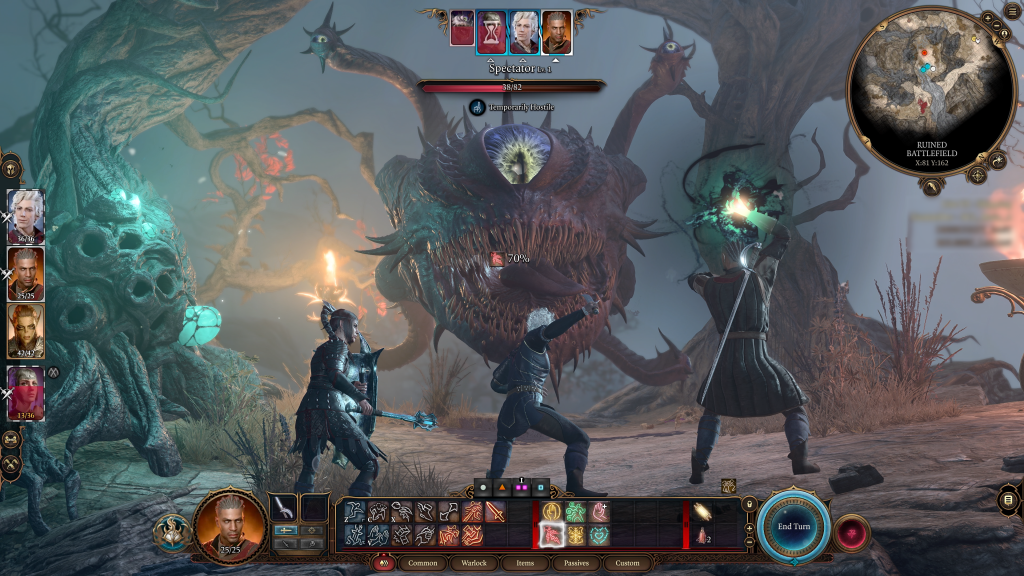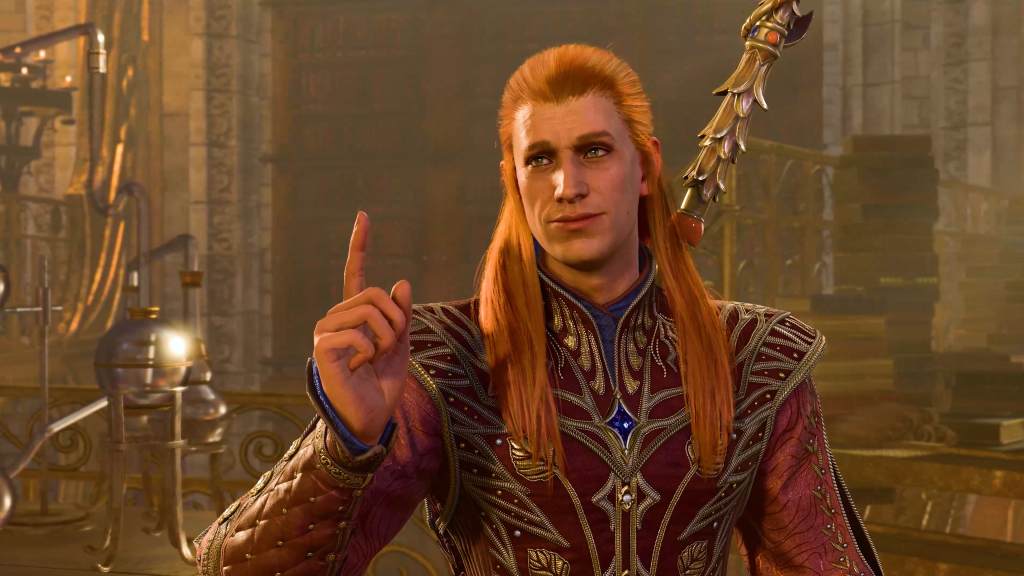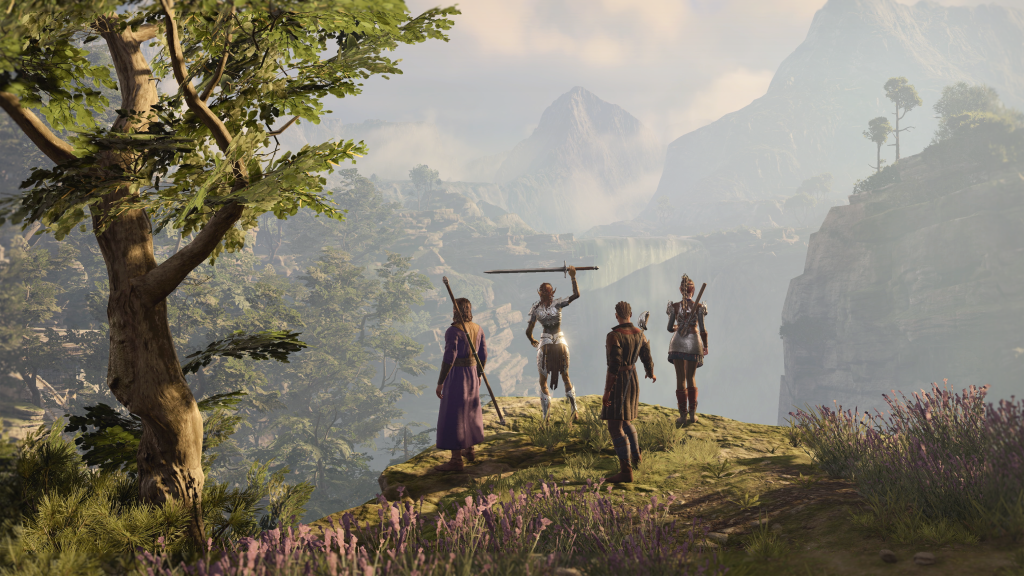Dungeons & Dragons saw an uptick in popularity during the pandemic as players used the technological magic of video calls to see and communicate with each other from across vast distances. Now that the world has returned to something that, at least on the surface, resembles pre-pandemic normalcy, it may be more of a challenge for those once-isolated adventurers to coordinate their schedules so that they may gather their party and venture forth on new journeys. While there’s nothing like having a group of friends to play Dungeons & Dragons with, Baldur’s Gate 3 — developed by Larian Studios, the team that made a name for itself in the CRPG space with its two Divinity: Original Sin games — does an impressive job of translating Dungeons & Dragons 5th Edition’s style of play into video game form.
Videos by ComicBook.com
I haven’t finished Baldur’s Gate 3. I feel I should mention that upfront. Despite the scores of hours I’ve put into the game, it still feels like I’ve only scratched its surface. But we stand on the precipice of relevancy for a review of the game, so here I am.

As Baldur’s Gate and Baldur’s Gate 2 did with Advanced Dungeons & Dragons, Baldur’s Gate 3 lifts its systems and gameplay from Dungeon & Dragons 5th Edition. Players create a character from preexisting race, class, and background. Ability and skill scores determine the character’s combat prowess and proficiency at different tasks. Once the game starts, the player’s character will eventually find some other adventurers to party up with (or not, if the player is determined to attempt a solo playthrough), and the quest begins.
But Baldur’s Gate 3 knows better than to try to draw players in with the tired “you all meet at the inn” trope. Instead, players wake up as prisoners aboard a nautiloid, one of the dimension-hopping ships belonging to the Illithid, also known as Mindflayers, a D&D-native race of Lovecraftian humanoids bent on dominating all life in the multiverse. Players with enough skill and luck will manage to escape the ship before it crashes into a hell dimension and demons ravage it, but not before an Illithid tadpole, used to turn unwilling hosts into new MIndflayers, is put behind their eye.
Even from this early point in Baldur’s Gate 3, it became apparent that no two playthroughs of this game would ever be alike. To escape the nautiloid, the player must cross the ship’s bridge, where Mindflayers are battling demons, without being killed and before a short time limit (determined by turns) runs out. I chose to play a Sorcerer powered by Wild Magic, which means my character’s spellcasting can sometimes have unintended consequences, sometimes for good and sometimes for ill. In this case, I triggered a side effect that let me swap places with any other creature, turning the challenge into a cinematically-choreographed sequence in which my half-elven hero teleported across the battlefield by leaping from one demon to the next, achieving the goal with ease.
By contrast, a friend of mine quickly died in the tutorial after rolling a natural 1 — called a critical failure in D&D — on a role to resist a Mindflayer’s psionic compulsions and having his brains eaten. Very different experiences, yes, but both were memorable in different ways.

Baldur’s Gate 3 sells the Dungeons & Dragons experience in how it presents its systems. Where the original Baldur’s Gate saga mostly hid its dice rolls for immersion’s sake, every contested interaction in Baldur’s Gate III hinges on a skeuomorphic die roll. A separate overlay overtakes the screen with a virtual 20-sided die at its center. Here, every bonus applied to that die roll based on a character’s stats shows up for the player to calculate, as well as all of the optional advantages they can gain via additional powers offered by their party.
In another nod to the game’s tabletop roots, Baldur’s Gate 3‘s combat is fully turn-based, which is how it works in tabletop Dungeons & Dragons. Upon entering a hostile situation, the game automatically roles initiative for the entire party and the threats they’re facing. Each character involved in combat takes their turn in order, able to move, take a standard action, and take a bonus action for a lesser act. It’s less rote than it sounds. Combat is challenging and requires carefully planned synergy between party members to achieve the best results even on the base difficulty. It also rewards creative thinking. For example, I managed to practically one-shot a boss by shoving them into a chasm of giant spiders I hadn’t gotten around to clearing. Fight smarter, not harder, my friends.
Baldur’s Gate 3 winds up feeling close to playing a game of Dungeons & Dragons, albeit with a Dungeon Master lenient enough to let the party cleric retroactively cast Guidance before every die roll, adding another four-sided die to the total. It’s also a situation where one player (outside of multiplayer mode) controls the entire party in combat, which turns that aspect of the game into more strategy and less team-building exercise.
Oh, and save scumming. The autosave function isn’t generous, but being able to save mid-combat and mid-conversation more than makes up for that if you’re the type who appreciates a do-over. I tend to myself, though I almost exclusively feel compelled to use the reload hot button when I’ve misunderstood the context of the conversation or the mechanics of the action I took. For example, I used the spell Mage Hand to toss a dwarf stranded among a field of explosive mushrooms his backpack with the scroll he needed to escape. Because I didn’t understand how the spell works with Baldur’s Gate 3‘s interface, I accidentally tossed the bag into the mushrooms, setting off what had to be the most impressive chain reaction explosion I’ve ever seen in a roleplaying game and blowing the poor dwarf into oblivion. Once I stopped laughing, I loaded my latest save and did what I meant to do, which is what my character, in-game, would almost certainly have known how to do correctly the first time. However, I’d encourage players to use this feature with restraint because Larian seems to have learned one of the vital lessons of any great Dungeon Master, that every failure should create new opportunities as exciting as the ones seemingly lost.

However, this leads to one concern: the game is a lot. Dungeons & Dragon‘s 5th Edition ruleset is considered pretty streamlined compared to past versions. However, it remains complex enough that presenting it as a video game interface is initially intimidating. Even with experience playing tabletop Dungeons & Dragons, it took some time for me to understand how spells and abilities are organized in the ability bar and how to employ them correctly. It seems likely to be overwhelming for someone with no D&D experience.
I haven’t talked much about the story beyond the introductory section. As mentioned, I haven’t completed the game, so I can’t talk about whether or not it sticks is landing. However, what I have experienced is stellar. Many of the companion characters you encounter and can potentially recruit appear, at first, to be stock charters but soon reveal some subversion of the typical expectations. Having a cleric around in the party to do healing is no surprise, but what if that cleric worships the wrong kind of god? What if the folk hero in the group got his power from the wrong place? What if the noble knight in the group is something of a xenophobic jerk? Each of these characters has a storyline to explore if the player chooses, and doing so reveals a recurring theme. Almost every companion’s story hinges on an exchange of power between a mortal and a higher being. It plays out in the big picture and the personal quests, in the form of Faustian bargains and demonic pacts, but sometimes the characters aren’t willing participants in these exchanges.
The theme comes through in the gameplay as well as players must decide whether to try to turn that Mindflayer tadpole in their eye to their advantage, adding a press-your-luck aspect to where story — involving a mysterious dream visitor who may or may not be the player character’s guardian angel — meets gameplay. But it’s important to note that how you obtain your power and choose to wield it are two different things. That dissonance creates the opportunity for characterizations far outside the Paragon-Renegade spectrum.
Baldur’s Gate 3‘s dedication to D&D does mean it gets weighed down with some tedium that an actual Dungeon Master might dispense. Larian has done a commendable job of making inventory management better than in past Baldur’s Gate games, but it’s still a chore. I dread trips to merchants to unload my accumulated treasure more than even the most intimidating boss battle. I know they wanted players to have the option to throw the rotten cheese they found in the cupboard at the next Bugbear they see, but maybe it’s okay to cut a corner or two here or there.

Outside of Dungeons & Dragons, playing Baldur’s Gate 3 reminded me most of Playing Dragon Age: Origins, specifically the PC version BioWare had been developing before Electronic Arts acquired the company. BioWare conceived Dragon Age as a single game meant to pay homage to the original Baldur’s Gate saga, the studio’s first big success story. Not since then have I amassed a party of RPG characters as motley as they are compelling, and not since then have I seen a game thoroughly revel in the unique delights of a CRPG genre while refining them and pushing them to new levels of polish as I’ve seen in Baldur’s Gate 3. EA long abandoned that original premise of Dragon Age, turning it into a franchise in pursuit of console-born profits (Dragon Age: Origins sold exponentially better for consoles than for PC, despite the console version of the game being a late-in-development port by an outside studio that played quite differently from the PC version), it’s almost poetic that Baldur’s Gate 3 should pick up that torch that BioWare lit and then set down years ago. Baldur’s Gate 3 is a beacon of all the untapped potential in the CRPG genre. While it may be a bit much for newcomers, it’s a gripping experience that no one with even an inkling of interest in the genre should miss.
Rating: 4.5 out of 5
Baldur’s Gate 3 is available now for PC with a PS5 version releasing on September 6th. A review code was provided by the publisher for the purpose of this review.








